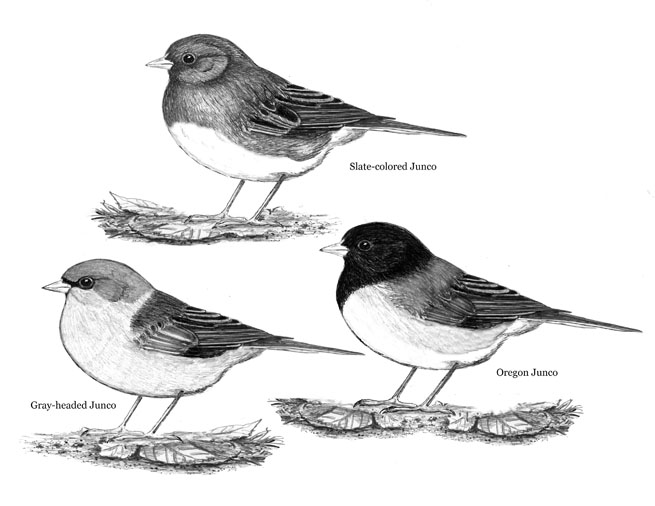
Dear Bird Folks,
In last week’s column I read about your trip to New Mexico and it reminded me about the time I visited my friend in Albuquerque. She had lots of birds on her feeders, but the ones that caught my eye were the juncos. She had several different species of them in her yard. Here in Wareham I’m lucky to get one species. Did you see lots of different juncos on your trip?
– Eric, Wareham, MA
Yes, I did, Eric,
New Mexico was like going to Junco Heaven. They were everywhere. At first I didn’t pay much attention to them. I can see juncos around here. I wasn’t going to waste my time watching those little gray birds when I could be looking for such western rarities as Black-headed Grosbeaks, Lazuli Buntings or a restaurant that served something without chili peppers in it. That all changed when a snowstorm prevented us from doing much driving. It wasn’t a big storm, but my wife thought it would be better if we spent the day in the safety of Santa Fe’s clothing stores. So that’s what we did. Well, we did it until I heard that an Audubon center just was down the street. Snow or no snow, we were going birding. Clothes shopping would have to wait…at least for a few hours.
A short distance from Santa Fe’s famous plaza is the Randall Davey Audubon Center. By the time we got there the snow had really started to pick up and the mountain trails were too slippery for us flatlanders to hike on. So instead of hiking we went inside the nature center, where a lonely Audubon lady was thrilled to see us…or anybody else on this snowy day. She took us to a room that had huge windows that overlooked a small garden containing several feeders. It was perfect. As the snow swirled around outside, we comfortably sat and watched Cassin’s Finches, Canyon Towhees, Curve-billed Thrashers and Western Scrub-Jays come to the feeders. But the birds that put on the best show were the juncos. In a garden that wasn’t much bigger than the average living room, we saw not one, not two, but five different kinds of juncos. There were Slate-colored, White-winged, Gray-headed, Oregon and the flamboyant Pink-sided Juncos (yes, that’s a real bird). Suddenly, they weren’t boring old juncos anymore. In fact, juncos aren’t boring at all. They are one of the most confusing and argued-about birds in North America. And believe me, birders love to argue.
All of the above juncos (White-winged, Gray-headed, Oregon, etc.) are distinctive and clearly look different from each other. But here’s the odd part, they aren’t different species of birds. They are all one single species. Confused? I hope so, because everyone else is, too. For years we all happily thought that most of these dissimilar-looking juncos were separate species. Then in the 70s it was decided that these different juncos were actually geographic variations of one species, called the “Dark-eyed Junco.” This was big news. The birds themselves didn’t care, but the birders were very upset. In one day they lost several birds from their life lists. Some are still fighting about it. And believe me, birders love to fight for their life lists.
Juncos are actually sparrows that were given their own special name for some reason. It is thought that the name “junco” is derived from the Spanish word for “rushes,” those reedy plants that are found in wet habitats. But since juncos prefer a dry habitat, the name doesn’t make much sense. Like most sparrows, juncos spend most of their time picking up seeds and small insects off the ground. What sets juncos apart from the other sparrows is that juncos tend to be mostly gray (not streaky brown), with white bellies. They also have white outer tail feathers that flash when the birds fly. In addition, juncos have pink beaks, which helps with identification, but requires constant applications of zinc oxide in the summer.
The most widespread, and the junco that we see here in the East, is the Slate-colored Junco. For most of the year, Slate-colored Juncos enjoy their life away from our yards, but the minute the snow starts to fall, these little gray birds magically appear under our feeders. This gives them the nickname of…. Oh, man, I can’t think of it right now, but it will come to me. Researchers have learned that this complicated bird also has a complex migration pattern. Most Slate-colored Juncos breed up in Canada and spend the winter farther south. But the young males do very little migrating and try to survive the winter close to the breeding grounds. The older females, on the other hand, travel great distances and enjoy the winter in the warmth of the southern states. Oddly, the younger females and the older males occupy the area between the two wintering grounds mentioned above. Ha! Those old guys know what they are doing.
I like Slate-colored Juncos, but the more colorful juncos inhabit much smaller ranges in the western part of North America. That’s why seeing them all eating in one snow-covered garden in Santa Fe was such a treat. And we were lucky. Not long after we arrived at the Audubon center, the snow stopped and the birds slowly began to disappear, which is why juncos are called “snowbirds.” Hey, that’s it, snowbirds. I knew I’d think of it.
I agree with you, Eric. Seeing the junco show in New Mexico was probably the highlight of my trip. Well, except for going shopping with my wife. There is nothing better than that. That’s what I’m supposed to say, right?